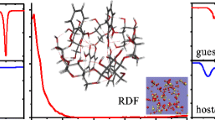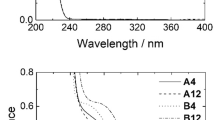Abstract
The formation of complexes of parent and alkylated cyclodextrins (CDs) with 1-heptanol and 1-octanol has been studied calorimetrically at 298 K in water and in concentrated aqueous solutions of urea. The forces involved in the association process are discussed in the light of the signs and values of the thermodynamic parameters obtained: association enthalpy, binding constant, Gibbs free energy, and entropy. It was inferred that: (i) in water, the formation of complexes for parent and substituted α-cyclodextrins (αCDs) is determined by enthalpy. For parent and substituted β-cyclodextrins (βCDs), instead, hydrophobic interactions are the prevailing forces determining complexation, as indicated by the small and negative or positive enthalpies and by the high and positive entropies. (ii) In urea, hydrophilic interactions are attenuated. The formation of complexes with alkylated CDs does not occur. (iii) The analysis of the thermodynamic properties confirms that inclusion is a process dominated by hydration phenomena. Modifications experienced by the solvent water in the hydration shells of the interacting substances upon association determine the formation of the complexes.


Similar content being viewed by others
References
Rekharsky MV, Inoue Y. Complexation thermodynamics of cyclodextrins. Chem Rev. 1998;98:1875–917.
Rekharsky MV, Inoue Y. Chiral recognition thermodynamic of β-cyclodextrin: the thermodynamic origin of enantioselectivity and the enthalpy–entropy compensation effect. J Am Chem Soc. 2000;122:4418–35.
Clarke RJ, Coates JH, Lincoln SF. Inclusion complexes of the cyclomalto–oligosaccharides (cyclodextrins). Adv Carbohydr Chem Biochem. 1988;46:205–11.
Connors A. The stability of cyclodextrins complexes in solution. Chem Rev. 1997;97:1325–57.
Bellia F, La Mendola D, Pedone C, Rizzarelli E, Saviano M, Vecchio G. Selectively functionalized cyclodextrins and their metal complexes. Chem Soc Rev. 2009;38:2756–81.
Zielenkiewicz W, Terekhova IV, Wszelaka-Rylic M, Kumeev RS. Thermodynamics of inclusion complex formation of hydroxypropylated α- and β-cyclodextrins with aminobenzoic acids in water. J Therm Anal Calorim. 2010;101:15–23.
Rekharsky MV, Mayhew MP, Goldberg RN, Ross PD, Yamashoji Y, Inoue Y. Thermodynamic and nuclear magnetic resonance study of the reactions of α- and β-cyclodextrin with acids, aliphatic amines, and cyclic alcohols. J Phys Chem. 1997;101:87–100.
Castronuovo G, Niccoli M, Varriale L. Complexation forces in aqueous solutions. Calorimetric studies of the association of 2-hydroxypropyl-β-cyclodextrin with monocarboxylic acids or cycloalkanols. Tetrahedron. 2007;63:7047–52.
Ross PD, Rekharsky MV. Thermodynamics of hydrogen bond and hydrophobic interactions in cyclodextrins complexes. Biophys J. 1996;71:2144–54.
Liu L, Guo Q-XJ. The driving forces in the inclusion complexation of cyclodextrins. J Inclusion Phenom Macrocycl Chem. 2002;42:1–14.
Liu L, Guo Q-XJ. Use of quantum chemical methods to study cyclodextrins chemistry. J Inclusion Phenom Macrocycl Chem. 2004;50:95–103.
Hallén D, Schön A, Shehatta I, Wadsö I. Microcalorimetric titration of α-cyclodextrin with some straight-chain alkan-1-ols at 288.15, 298.15, and 308.15 K. J Chem Soc Faraday Trans. 1992;88:2853–9.
Terechova IV, De Lisi R, Lazzara G, Milioto S, Muratore N. Volume and heat capacity studies to evidence interactions between cyclodextrins and nicotinic acids in water. J Therm Anal Calorim. 2008;92:285–90.
Brewster MF, Loftsson T. Cyclodextrins as pharmaceutical solubilizers. Adv Drug Deliv Rev. 2007;59:645–66.
Uekama K, Hirayama F, Irie T. Cyclodextrin drug carrier systems. Chem Rev. 1998;98:2045–76.
Junquera E, Ruiz D, Aicart E. Role of hydrophobic effect on the noncovalent interactions between salisilic acid and a series of β-cyclodextrins. J Colloid Interface Sci. 1999;216:154–60.
Todorova NA, Schwarz FP. The role of water in the thermodynamics of drug binding to cyclodextrins. J Chem Throdynam. 2007;39:1038–48.
Aki A, Ikeda H, Yukawa M, Iwase Y, Mibu N. Effect of pH on the formation of inclusion complexes between β-lactam antibiotics and 2-hydroxypropyl-β-cyclodextrin in aqueous solution. J Therm Anal Calorim. 2009;95:421–6.
Zielenkiewicz W, Terekhova IV, Marcinowicz A, Kozbial M, Poznanski J. Interactions of native and modified cyclodextrins with some B-vitamins. J Therm Anal Calorim. 2008;93:365–72.
Zielenkiewicz W, Terekhova IV, Kozbial M, Kumeev RS. Thermodynamic study on inclusion complex formation of riboflavin with 2-hydroxypropyl-β-cyclodextrin in water. J Therm Anal Cal DOI:10.1007/s10973-010-0858-x.
Castronuovo G, Elia V, Niccoli M, Velleca F. The effects of cosolvents on the complexation of α-cyclodextrin with alkylated substances. Calorimetric studies at 25 °C. J Inclusion Phenom Macrocycl Chem. 2002;44:229–34.
Castronuovo G, Elia V, Niccoli M, Velleca F, Viscardi G. Role of the functional group in the formation of the complexes between α-cyclodextrin and alkanols or monocarboxylic acids in aqueous solutions. A calorimetric study at 25 °C. Carbohydr Res. 1998;306:147–55.
Andini S, Castronuovo G, Elia V, Gallotta E. Inclusion compounds in water. Calorimetric and spectroscopic studies of the interaction of cyclomaltohexaose (cyclodextrin) with alkanols at 25 °C. Carbohydr Res. 1991;217:87–97.
Castronuovo G, Elia V, Iannone A, Niccoli M, Velleca F. Factors determining the formation of complexes between alpha-cyclodextrin and alkylated substances in aqueous solutions: a calorimetric study at 25 °C. Carbohydr Res. 2000;325:278–86.
Castronuovo G, Elia V, Niccoli M, Velleca F. Study of the effects of cosolvents on the complexation of β-cyclodextrin with alkanols by calorimetry at 298 K. J Incl Phenom Macrocycl Chem. 2003;45:91–7.
Castronuovo G, Niccoli M, Velleca F. Complexation of modified cyclodextrins with hydroxylated substances in aqueous solutions. Calorimetric studies at 298 K. Phys Chem Chem Phys. 2003;5:2658–62.
Castronuovo G, Niccoli M. Complexation of natural and methylated β-cyclodextrins with long chain carboxylic acids in aqueous solutions. Calorimetric studies at 298 K. J Inclusion Phenom Macrocycl Chem. 2005;53:69–76.
Castronuovo G, Niccoli M. Thermodynamics of inclusion complexes of natural and modified cyclodextrins with propranolol in aqueous solution at 298 K. Bioorg Med Chem. 2006;14:3883–7.
Castronuovo G, Niccoli M. The influence of cosolvents on hydrophilic and hydrophobic interactions. Calorimetric studies of parent and alkylated cyclomaltooligosaccharides in concentrated aqueous solutions of ethanol or urea. Carbohydr Res. 2008;343:2771–5.
Eftink M, Biltonen R. Thermodynamics of interacting biological systems. In: Beezer AE, editor. Biological microcalorimetry. London: Academic Press; 1980. p. 343–412.
Castronuovo G, Elia V, Fessas D, Velleca F, Viscardi G. Thermodynamics of the interaction of α-cyclodextrin with monocarboxylic acids in aqueous solutions: a calorimetric study at 25 °C. Carbohydr Res. 1996;287:127–38.
Castronuovo G, Niccoli M. The cavity elongation effect. Calorimetric studies of the complexes of long-chain carboxylic acids with methyl-α-cyclodextrin in aqueous solutions. J Incl Phenom Macrocycl Chem. 2007;58:289–94.
Lumry R, Rajender S. Enthalpy–entropy compensation phenomena in water solutions of proteins and small molecules: a ubiquitous property of water. Biopolymers. 1970;9:1125–12227.
Grunwald E, Steel C. Solvent reorganization and thermodynamic enthalpy–entropy compensation. J Am Chem Soc. 1995;117:5687–92.
Lo Meo P, D’Anna F, Gruttadauria M, Riela S, Noto R. Thermodynamics of binding between α- and β-cyclodextrins and some p-nitro-aniline derivatives: reconsidering the enthalpy–entropy compensation effect. Tetrahedron. 2004;60:9099–111.
Tabushi I, Kiyosuke Y, Sugimoto T, Yamamura K. Approach to the aspects of driving force of inclusion by α-cyclodextrin. J Am Chem Soc. 1978;100:916–9.
Inoue Y, Hakushi T, Liu Y, Tong L, Shen B, Jin D. Thermodynamics of molecular recognition by cyclodextrins. 1. Calorimetric titration of inclusion complexation of naphthalenesulfonates with α-, β-, and γ-cyclodextrins: enthalpy–entropy compensation. J Am Chem Soc. 1993;115:475–81.
Inoue Y, Liu Y, Tong L, Shen B, Jin D. Calorimetric titration of inclusion complexation with modified β-cyclodextrins. Enthalpy–entropy compensation in host–guest complexation: from ionophore to cyclodextrin and cyclophane. J Am Chem Soc. 1993;115:10637–44.
Author information
Authors and Affiliations
Corresponding author
Rights and permissions
About this article
Cite this article
Castronuovo, G., Niccoli, M. Solvent effects on the complexation of 1-alkanols by parent and modified cyclodextrins. Calorimetric studies at 298 K. J Therm Anal Calorim 103, 641–646 (2011). https://doi.org/10.1007/s10973-010-0965-8
Received:
Accepted:
Published:
Issue Date:
DOI: https://doi.org/10.1007/s10973-010-0965-8




